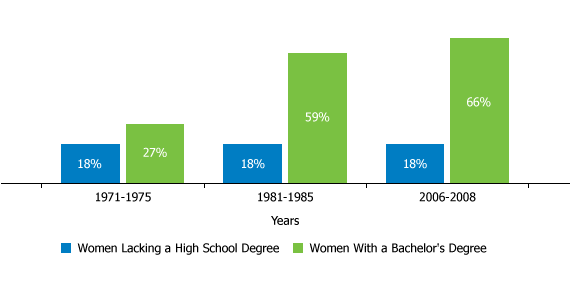
Working Mothers With College Degrees See Gains in Paid Maternity Leave
(February 2012) Working mothers with a bachelor’s degree have gained increasing access to paid leave in recent decades, while women without high school degrees have seen no change, reported Nancy Folbre, a University of Massachusetts economist. About two-thirds of first-time mothers had access to paid leave (maternity leave, sick leave, or vacation leave) between 2006 and 2008, an 11 percent increase since 1985, according to census data.1 These women have more than doubled their access to paid leave since 1975.
While educated women have made these small but significant gains, women lacking a high school degree have been stuck for more than 30 years, Folbre argued during a Population Association of America webinar, Balancing Employment With Child and Elder Care: The Implications of Changing Workplaces and Families. Women without high school diplomas have been unable to increase their access to paid leave since 1975; the share with such benefits has remained at 18 percent (see figure). “It seems pretty clear that educated women have been able to bargain either explicitly or implicitly for greater access to private benefits,” she said.
Changes Over Time in Mothers’ Access to Paid Leave, by Educational Level

Note: Leave includes maternity leave, sick leave, or vacation leave at first birth.
Source: Lynda Laughlin, “Maternity Leave and Employment Patterns: 2006–2008,” Current Population Reports P70-128 (October 2011).
In the United States, new mothers are not guaranteed any paid maternity leave; in many parts of Europe, however, paid leave is widespread, including as much as 42 weeks in Norway and Sweden. A recent study by the Rutgers University Center for Women and Work underscores the benefits of paid family leave to working families and to business and society.2 The study found that new mothers who use paid leave are more likely to still be employed and less likely to receive public assistance and food stamps in the year following a child’s birth than those who do not take any leave.
Under federal legislation, U.S. workers are able to take unpaid family leave, but only for 12 weeks at a time—and only if they are employed in a workplace with 50 or more people, Folbre noted. “That leaves a large share of our workforce uncovered,” she said. “And there’s evidence that take-up of unpaid family leave is relatively low because it’s very difficult for working families to afford to take that time.”
A handful of states, however, are providing some form of paid leave to workers, she said. California, Hawaii, New Jersey, New York, and Rhode Island have disability programs that allow women to recover some lost wages from pregnancy, according to the Rutgers Center for Women and Work. In addition, California and New Jersey have passed laws to provide an additional six weeks of paid family leave for care of a newborn or a newly adopted child funded through payroll taxes.
Compared with other affluent countries, the United States also provides less support for child care: Only 53 percent of U.S. children ages 3 to 5 were enrolled in publicly provided or publicly subsidized care in the early 2000s, compared to 99 percent of children in the same age group in Belgium and France, and 77 percent in Germany and the United Kingdom, according to the Luxembourg Income Study. One-third of employed U.S. mothers reported paying for child care for at least one of their children in 2010. Families in poverty who paid for care spent 40 percent of their monthly income on child care, compared with 7 percent among other families. Folbre called this difference a “distinct inequality” faced by low-income, low-educated women who try to balance work and child care.
One noteworthy trend is that more fathers are now stepping up to provide regular child care, Folbre pointed out. “It’s really interesting to note that married women now enjoy more assistance from the fathers of their children than they have in the past. But this is not a benefit that unmarried mothers have enjoyed, so there’s a big disjunction there,” she said. Thirty-two percent of married fathers provided care in 2010, up significantly from 26 percent in 2002.
Tyjen Tsai is a writer/editor at the Population Reference Bureau.
References
- Lynda Laughlin, “Maternity Leave and Employment Patterns: 2006–2008,” Current Population Reports P70-128 (October 2011).
- Linda Houser and Thomas P. Vartanian, Pay Matters: The Positive Economic Impacts of Paid Family Leave for Families, Businesses, and the Public, (New Brunswick, NJ: Rutgers Center for Women and Work, 2012), accessed at http://news.rutgers.edu/medrel/news-releases/2012/01/rutgers-study-finds-20120118, on Jan. 26, 2012.
